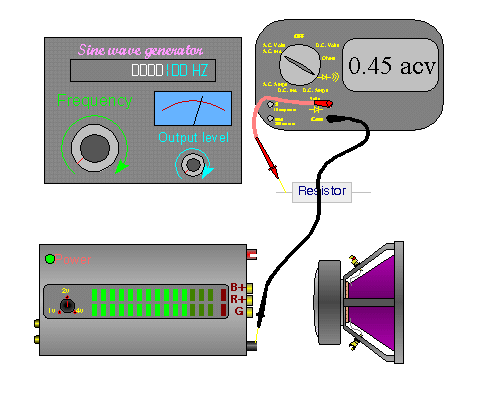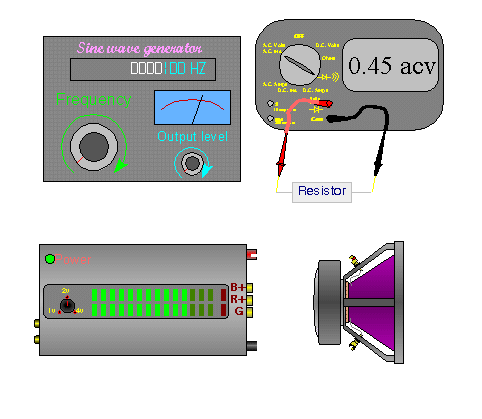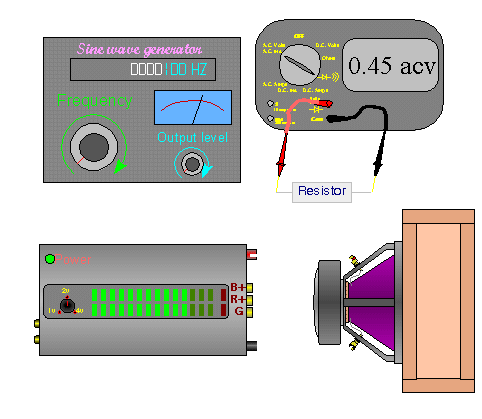|
Finding the Basic Thiele/Small Parameters
The following will lead you through the test procedure needed to find some of the T/S parameters of your speaker.
-
You'll need:
-
a 4-8 ohm resistor rated for at least 5 watts
-
An amplifier which has a flat frequency response from 20-100hz
-
A sine wave generator with frequency counter or an external frequency counter
-
A test enclosure with a known internal volume
-
A digital multi-meter. A true RMS meter will be the most accurate.
Note:
Disregard the readings on the test equipment in the diagram.
Set your meter to ohms and measure the resistance of the speaker and the resistor. Enter these values in fields '1' and '2'.
Make the connections as shown below and set the generator's frequency to somewhere between 40 and 100 hz. Set the generator's output so that the amplifier produces approximately 3 volts AC. Enter the exact output voltage in field '3'. Do not change the output level for the rest of the testing. To mute the audio, turn the amplifier off.

Now make the connections as shown below. Adjust the frequency of the generator until you get the lowest possible voltage reading across the resistor. This is the resonant frequency of the speaker. The reason that the voltage is lowest at this point is because the impedance of the speaker is at its highest. When the speaker's impedance increases, the current flow decreases. Since there is less current flowing through the resistor, there is a smaller voltage drop across the resistor. Enter the minimum obtainable voltage into field 5 below. Enter the frequency where the minimum voltage was obtained into field 4. Click on 'calculate'. Don't be concerned by the erroneous values in some of the fields. We're only half way through the test.

Adjust the frequency of the generator down until the voltage across the resistor is the same as the field marked 'Resistor's 3dB Down Voltage'. Enter the frequency into field 7. Now go up in frequency past the resonant frequency to the point where the voltage is again the same as 'Resistor's 3dB Down Voltage'. Enter this value into field 6.
Measure and enter the internal volume of the enclosure into field 9. Mount the speaker in or on the enclosure. If you mount it 'in' the enclosure, subtract the appropriate amount from the enclosure's volume (see table below). Find the resonant frequency of the speaker in the enclosure by finding the frequency where the voltage across the resistor is lowest. Enter this value into field 8. Click on 'calculate' again. If the speaker's calculated resonant frequency is significantly different from the value that you measured earlier, you may not have been careful enough in your measurments. The values output by this calculator should be very close to the published specifications for the driver.

|
8 inch =
|
0.03 ft3
|
|
10 inch =
|
0.05 ft3
|
|
12 inch =
|
0.07 ft3
|
|
15 inch =
|
0.10 ft3
|
There are several things that will change some of the parameters of the speaker. None of the following will make a huge difference in the resonant frequency (except, maybe, the first one in the list below) but they will make a difference. If you can not get consistent measurements, some of the following may be the cause.
-
Notes:
-
Physical relationship to objects around the speaker:
When measuring the resonant frequency of a speaker, you must make sure that nothing is reacting with the speaker except free air. Most people hang the speaker from a string when finding the resonant frequency. The speaker should not be hanging near any other objects. If it's hanging within ~12" from any object, the object may affect the measured resonant frequency. You can confirm that this is true by placing your hand in front of the speaker when reading the voltage across the resistor. Moving your hand closer to the speaker will change the voltage reading across the resistor. If you measure the resonant frequency with the speaker laying on its magnet, you'll get slightly skewed readings. If the magnet has a vented pole piece, the readings will be even more skewed. For an 8" woofer that I was testing, the difference between the free air resonance and resonance with the speaker within 1" of a wall, was about 2.5%. This isn't a big difference but I'm mentioning it so that you'll realize that little things can cause variations in your measurements.
-
Temperature:
Most speaker components are, at least, somewhat sensitive to temperature. This is especially true for the spider and the surround. At very low temperatures, they will be less compliant (which will give a higher resonant frequency). At higher temperatures, the spider and surround will be more compliant and will produce a lower resonant frequency. For critical measurements, you should measure the resonant frequency at the same temperature as the environment where the speaker will be used. For home speakers, this is easy. For car speakers, the wide temperature variations make it more difficult to pick a temperature at which to test.
-
Humidity:
Some speakers (especially those with untreated paper cones) will absorb moisture and will therefore have a slightly different resonant frequency when the air is very humid or very dry.
-
'Breaking in' the Speakers:
'Some' speakers need to be played a while before they obtain a stable compliance. Fresh out of the box, the suspension may be somewhat stiff (mainly due to the material that's used for the spider). After playing them a while, the suspension will soften a little. If you want to break them in, play them at a very low frequency (preferably at resonance) for 10 minutes or so. Drive them with enough power to move the cones about 2/3 of Xmax. With the speakers hanging in free air and at resonance, there will be virtually no chance of injuring the speakers. Remember, at resonance, the speaker moves significantly with very little power applied. The combination of very high impedance and significant cone movement virtually eliminates any chance of overheating the voice coil. This should not be done with the speakers in an enclosure, lying face down or on their magnets (especially if they have a vented pole piece).
-
Test Equipment:
Professional quality test equipment won't be affected much by temperature. That said, it's best if you allow the test equipment to reach 'room temperature' if you want reliable measurements. If your meter was in the trunk of your car baking in the hot sun and you make the measurements as soon as you bring it in to the test area, you may get significantly different readings than you will when the meter cools down. The same goes for the signal generator/frequency counter.
-
Meter Frequency Response:
Before you get started, you should connect your meter directly across the signal generator and check to see that the voltage doesn't vary as you sweep the frequency from ~20hz to ~100hz. If the voltage starts to drop near 20 hz, you may want to find a true RMS meter to do the tests.
For the most accurate measurements, I would hang the speaker in the middle of a room in your home (or temperature controlled shop). This will provide a stable, consistent environment for your tests. Allow all test equipment and speakers to reach room temperature before testing. To get consistent measurements, you need to have consistent test conditions.
As a side note, Someone once told me that hanging the speaker can cause the measured resonant frequency to be off because the magnet/frame structure moves a little. They said that the speaker had to be mounted securely into an infinite baffle to give accurate measurements. I can not deny or confirm this statement.
|







